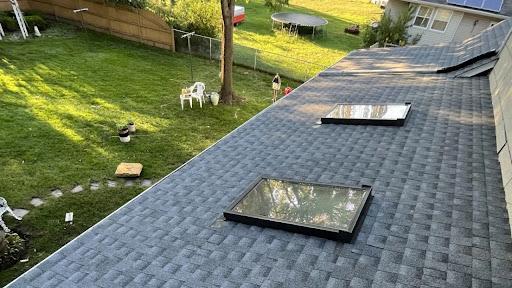Blogs

How Long To Repair A Roof & Risks Of Not Fixing A Leak?
Roof repair time varies by damage severity: minor repairs take a few hours to a day, moderate repairs may take one to two days, and major repairs can take several days to a week. Delaying repairs can lead to structural damage, increased repair costs, health hazards like mold, damage to interior spaces, and higher energy bills. Promptly fixing leaks is essential to prevent further issues. Whether you're dealing with a minor leak or extensive damage, the question arises: How long does it take to repair a roof, and what could happen if you don't fix a leak promptly?
In this article, we will explore the factors influencing roof repair timelines, how long roof repairs typically take, and the risks associated with neglecting roof leaks. At Northeast Exteriors, a trusted roofing contractor in Palmyra, NJ, we are dedicated to helping homeowners in the greater Philadelphia and South Jersey areas protect their investment with high-quality roofing solutions. From minor repairs to full roof replacements, our experienced team ensures your home remains safe and secure.
Key Takeaways
Roof repairs can take anywhere from a few hours to several days, depending on the severity of the damage.
Minor repairs can be completed in a day, while moderate repairs may take one to two days.
Major repairs or roof replacements may take several days to a week or more.
Ignoring roof leaks can cause structural damage, increased repair costs, health hazards, and energy inefficiencies.
Prompt repairs are essential to maintaining the integrity of your home and protecting your investment.
How Long to Repair a Roof?
The time it takes to repair a roof can vary greatly depending on several factors such as the extent of the damage, the type of roofing material, weather conditions, and the complexity of the repair itself. Here's an overview of the typical repair times for different scenarios:
1. Minor Repairs (a few hours to one day)
Minor repairs typically involve small fixes such as replacing a few missing shingles or addressing small leaks. These repairs can often be completed quickly and efficiently, usually taking a few hours or a full day. Here are the details:
Small Leaks: Fixing a minor leak typically takes a few hours.
Missing or Broken Shingles: Replacing a few shingles can often be done in under a day.
Damaged Flashing: Repairing or replacing flashing might take just a few hours.
2. Moderate Repairs (one to two days)
Moderate roof repairs generally involve issues like widespread shingle damage, multiple leaks, or localized water damage. These repairs require more time due to the increased scale and potential for more complex fixes.
Multiple Leaks: If there are several leaks to address, this may take a full day or more.
Widespread Shingle Damage: Replacing sections of damaged shingles or damaged underlayment might take one to two days.
Localized Water Damage: Fixing water damage on interior spaces and repairing the roof sections will take a bit more time.
3. Major Repairs (several days to a week or more)
Major repairs are needed when there is significant structural damage, or the roof is at the end of its lifespan. This type of repair can take several days, or even a week, depending on the severity of the damage.
Structural Damage: Extensive damage to the roof’s framework or decking may take multiple days to repair.
Complete Roof Replacement: Replacing an entire roof is a large project that could take several days to a week or more, depending on the materials used.
Complex Roof Features: Roofs with complicated slopes, valleys, or multiple layers may require more time to repair.
Factors That Affect Repair Time
The timeline for roof repairs is influenced by several factors beyond the damage itself. Here’s what to keep in mind:
Weather Conditions: Adverse weather, like rain or high winds, can delay repairs and extend the repair timeline.
Roofing Materials: Different materials such as shingles, rubber, or metal require different processes, affecting repair time.
Type of Roof: Flat roofs, multiple sloped roofs, or complex designs may need more time for repairs compared to simpler roofs.
Risks of Not Fixing a Leak
Ignoring a roof leak might feel like a quick way to save on repairs, but it can lead to serious long-term consequences. These risks can compound over time, increasing both the financial and structural impact. Here's a breakdown of the key risks involved:
1. Structural Damage
Even a minor leak can cause significant structural issues over time. Water entering through the roof can weaken the integrity of key structural elements, leading to a potential collapse. The longer the leak goes unfixed, the worse the damage becomes.
Rotting Beams: Prolonged exposure to moisture can cause the wooden beams in the roof and ceiling to rot, weakening the structure.
Ceiling Damage: Water leakage can cause ceilings to sag, crack, or even collapse if the problem worsens.
Potential Roof Collapse: In extreme cases, untreated leaks can cause the entire roof to collapse, resulting in a massive repair job.
2. Increased Repair Costs
When a roof leak is left unchecked, a small problem can snowball into a much bigger one, ultimately requiring more extensive repairs and larger expenditures. Delaying fixes can turn an affordable repair into an overwhelming expense.
Worsening Damage: Water can spread throughout the roof and other parts of the house, expanding the problem.
Expensive Material Replacements: As the leak grows, more materials may need to be replaced, such as insulation, drywall, or roof decking.
Complicated Repairs: Larger areas of the roof or interior may need repairs, which takes more time and labor, leading to increased costs.
3. Health Hazards
Roof leaks don't just damage your home—they can also impact your health. Moisture trapped in the house promotes mold and mildew, which can spread quickly and cause serious health problems if left untreated.
Mold Growth: Leaks create a damp environment, allowing mold and mildew to thrive, which can affect air quality.
Health Risks: Mold exposure is linked to respiratory issues, asthma, allergies, and other chronic conditions.
Expensive Mold Remediation: Mold remediation requires professional help and can be quite costly if the mold spreads too far.
4. Damage to Interior Spaces
Roof leaks not only affect the structure but can also damage your home’s interior. Water seeping through ceilings, walls, and floors can harm furniture, electronics, and personal belongings. This damage can be costly and disruptive.
Water Stains: Water leaking into ceilings or walls can leave unsightly stains, which might require repainting or new finishes.
Furniture Damage: Leaks may cause water damage to furniture, electronics, or valuables that can be expensive to replace.
Flooring Damage: Moisture can warp or ruin floors, leading to costly replacements or repairs.
5. Increased Energy Costs
A leaking roof can cause your home’s insulation to become ineffective, leading to increased energy consumption. Without proper sealing, air can escape from your home, making it harder to maintain a consistent indoor temperature.
Heat Loss or Gain: Leaks allow hot air to escape in the winter or let in heat in the summer, forcing your HVAC system to work harder.
Increased Heating and Cooling Bills: Your energy bills may spike as your heating or cooling system works overtime to compensate for air loss.
Reduced Insulation Effectiveness: Wet insulation loses its ability to properly insulate your home, leading to higher energy costs.
How to Choose a Reliable Roofing Contractor
When selecting a roofing contractor, it's crucial to choose someone trustworthy, experienced, and professional. This will ensure that your roof repair or replacement is done correctly, safely, and efficiently. Here's what you should consider when evaluating potential contractors:
Experience and Expertise: Look for a contractor with years of experience and specialized knowledge in roofing. This ensures they can handle various roofing materials and types, and they're prepared for any challenges that may arise during the job.
Positive Reviews and References: Check online reviews, testimonials, and ask for references from previous clients. A reliable contractor will have a solid reputation with happy customers.
Licensing and Insurance: Ensure the contractor is fully licensed and insured. This protects you from liability if any accidents happen during the job.
Transparent Pricing: Choose a contractor who offers clear and upfront pricing, including any potential additional costs. Avoid contractors who provide vague estimates or demand payment upfront.
Written Contract: Always get a detailed contract that outlines the scope of the work, materials, timeline, and payment schedule. This ensures both parties are on the same page and avoids any misunderstandings.
The Importance of Regular Roof Maintenance
Regular roof maintenance is essential for ensuring your roof remains in optimal condition. Routine inspections can catch potential issues early, preventing expensive repairs and extending the life of your roof. Here's why you should schedule annual maintenance:
Early Problem Detection: Regular inspections help spot small issues like leaks, damaged shingles, or debris buildup before they become major problems.
Prolonged Roof Lifespan: Roof maintenance ensures that your roof lasts as long as possible, saving you from the need for early replacements.
Prevention of Water Damage: Checking for leaks, missing shingles, and sealant issues helps prevent water from seeping into your home and causing interior damage.
Gutter Cleaning: Clearing out your gutters during maintenance helps prevent water backup, which can cause roof damage and foundation issues.
Energy Efficiency: Ensuring your roof’s insulation and ventilation are in top shape helps your home maintain a consistent temperature, reducing the strain on your HVAC system.
Energy Efficiency and Roofing Solutions
A well-maintained roof plays a key role in enhancing your home's energy efficiency. Proper insulation, ventilation, and materials can help reduce energy consumption, keep your home comfortable, and save you money. Here’s how roofing solutions can boost energy efficiency:
Proper Insulation: A roof that is properly insulated reduces heat loss during winter and prevents excess heat from entering during the summer, leading to lower energy bills.
Reflective Roofing Materials: Cool roofs or reflective coatings can help reduce heat absorption, keeping your home cooler in the summer and lowering cooling costs.
Roof Ventilation: Adequate ventilation allows heat to escape from your attic during the summer, reducing the need for air conditioning. This helps maintain a comfortable indoor temperature.
Energy-Efficient Shingles: Certain roofing materials, such as energy-efficient shingles, are designed to reflect sunlight and reduce the amount of heat transferred into the home.
Energy Rebates: Some energy-efficient roofing materials may qualify for local or federal energy rebates, providing you with additional savings on your roof installation or replacement.
Frequently Asked Questions About Roof Repair
How often does a roof need to be replaced?
A roof typically needs to be replaced every 20-30 years, depending on the roofing material. Asphalt shingles last about 20 years, while metal or tile roofs can last 40-70 years.
How quickly should a roof leak be repaired?
A roof leak should be repaired as soon as possible. Delaying repairs can cause further damage, leading to more costly repairs and structural issues.
How much damage does a roof need to be replaced?
If the damage is widespread, such as extensive shingle loss, significant leaks, or structural issues, a roof replacement may be necessary. A professional inspection can help determine if a repair or replacement is needed.
Contact Us for Roof Repair Services in Palmyra, NJ Today!
Ready to protect your home with reliable roof repairs? Northeast Exteriors is here to provide expert roofing solutions, from repairs to full replacements. Contact us today for top-notch service in Palmyra, NJ, and the greater Philadelphia & South Jersey areas.
Hours
Monday: 8:00AM - 6:00PM
Tuesday: 8:00AM - 6:00PM
Wednesday: 8:00AM - 6:00PM
Thursday: 8:00AM - 6:00PM
Friday: 8:00AM - 6:00PM
Copyright © Northeast Exteriors 2023. All Rights Reserved. Privacy Policy. Terms & Conditions. Web Design by Fused Media





